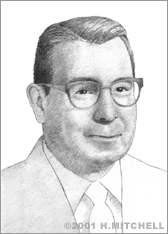Francis Turner
Francis “Frank” Turner is credited with having developed the interstate highway system, as we know it in the United States. In 1929, the Dallas native graduated from the Texas Agricultural and Mechanical College (now Texas A&M University) and immediately joined the Bureau of Public Roads as a Junior Highway Engineer. There, he was assigned to field service in the Bureau’s research program in what was then called the Division of Management. He was one of a group of college graduates selected each year to participate in a training program which focused on building methods designed to reduce the costs of highway construction. At the time, highway engineering was a brand new field.
During training, Frank learned to question construction procedures at the time and to be innovative and resourceful. He was transferred to the Arkansas Division office in Little Rock in 1933, where he was an Area Engineer responsible for a portion of the Arizona federal-aid highway program.
In 1940, Frank earned a graduate degree in civil engineering from Texas A&M. He continued to work for the Bureau of Public Roads in Washington, D.C. for a few years, then in 1943 he went to work on the Alaska Highway project as an “expediter,” where he lead the way in using aerial reconnaissance for highway location. In 1946, Frank headed to the Philippines, where he was in charge of restoring war-damaged roads and bridges. In 1951, the Philippine government recognized Frank’s work by making him a Member of the Legion of Honor.
Frank returned to the U.S. in 1950 to become the assistant to Commissioner Thomas H. MacDonald, who made him coordinator for the Inter-American Highway and projects in other countries. Some say the real father of the federal interstate system was President Dwight D. Eisenhower, who was inspired to create a better U.S. highway system after he saw the Autobahn in Germany. In the 1950's, Eisenhower, for whom military concerns were always top-of-mind, wanted to build a system of highways linking all parts of the country so as to facilitate the rapid movement of the military and civilians in case of an attack by the Soviet Union.
In 1954, when President Eisenhower appointed the President’s Advisory Committee on the
National Highway Program, Frank was named Executive Secretary to the committee. The modern interstate highway system was born June 29, 1956, when President Eisenhower signed the Federal Aid Highway Act of 1956, which provided for joint federal and state funding of interstate highways. Frank had served as liaison between the bureau and the congressional committees during the deliberations leading up to the creation of the Act.
From 1957 to 1969, as deputy commissioner, chief engineer, and then director of public roads, Turner was instrumental in helping to resolve many project disputes and keeping the interstate system’s progress on track. In February 1967, the U.S. Senate confirmed his appointment as Director of Public Roads. In 1969, he was appointed the federal highway administrator. He served in this position until his retirement on June 30, 1972.
Over the years, Frank received recognition for his leadership and contributions in transportation from many organizations. He was named Construction Man of the Year in 1967 and 1970 by Engineering News Record and also was named World Highway Man of the Year by the International Road Federation in 1969. In January 1999, Frank became the first recipient of the Frank Turner Medal for Lifetime Achievement in Transportation. He died in October of that year at age 90.


